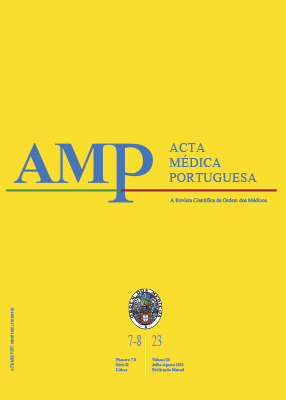Uma Abordagem Colaborativa para o Desenvolvimento de um Conjunto Padronizado de Resultados Centrados no Doente com Cancro de Cabeça e Pescoço
DOI:
https://doi.org/10.20344/amp.18180Palavras-chave:
Neoplasias da Cabeça e Pescoço, Cuidados Centrados no Doente, Avaliação de Resultados na Ótica do Doente, Indicadores de Qualidade, Cuidados de SaúdeResumo
Introdução: O cancro de cabeça e pescoço continua a ter um impacto considerável quer para o doente quer para os sistemas de saúde a nível mundial. Uniformizar os cuidados de saúde prestados a estes doentes, através da medição sistemática de indicadores estabelecidos, é fundamental para a melhoria contínua dos resultados em saúde. O objetivo deste estudo foi estabelecer um conjunto relevante de indicadores de resultados para o cancro de cabeça e pescoço e identificar ferramentas de medição e respetivos requisitos para a sua realização.
Métodos: Através de uma revisão exaustiva na literatura, obteve-se uma lista inicial de potenciais indicadores de resultados para o cancro de cabeça e pescoço. Um comité científico e dois grupos de trabalho regionais trabalharam em colaboração para reduzi-la por forma a obter um conjunto de indicadores ajustado à sua prática clínica. Esta lista foi depois avaliada por um representante de uma associação de doentes de cancro de cabeça e pescoço alcançando-se um conjunto final de indicadores.
Resultados: Da revisão literária, um total de 164 indicadores foram identificados abrangendo as dimensões de case-mix, resultados e eventos adversos. Estes foram, posteriormente, reduzidos a um conjunto de 79 indicadores pelo comité científico e divididos em sete categorias, incluindo demografia, estado clínico, parâmetros relacionados com o tumor, estado nutricional, tratamento, parâmetros de saúde e qualidade de vida, e sobrevida. Subsequentemente, essa lista foi ainda encurtada para 50 indicadores, pelos grupos de trabalho regionais, e reduzida para 49 indicadores pela avaliação final do comité científico. Por fim, os indicadores discutidos foram avaliados por um representante da associação de doentes, que acrescentou a categoria, ‘reabilitação’, parâmetro fundamental para estes doentes.
Conclusão: Um conjunto inicial de indicadores de resultados para cancro de cabeça e pescoço foi definido com o objetivo de padronizar a prática clínica a nível nacional e identificar as ferramentas de medição e os requisitos necessários para os medir. Este conjunto de indicadores deve ser continuamente melhorado e adotado de forma consistente nos diferentes contextos clínicos a nível nacional.
Downloads
Referências
Bray F, Ferlay J, Soerjomataram I, Siegel RL, Torre LA, Jemal A. Global cancer statistics 2018: GLOBOCAN estimates of incidence and mortality worldwide for 36 cancers in 185 countries. CA Cancer J Clin. 2018;68:394-424. DOI: https://doi.org/10.3322/caac.21492
El-Naggar AK, Chan JK, Grandis JR, Takata T, Slootweg P. WHO Classification of Head and Neck Tumours. In: WHO Classification of Tumours, 4th ed. Lyon: IARC Press; 2017.
The Cancer Genome Atlas Network. Comprehensive genomic characterization of head and neck squamous cell carcinomas. Nature. 2015;517:576-82. DOI: https://doi.org/10.1038/nature14129
Leemans CR, Snijders PJ, Brakenhoff RH. The molecular landscape of head and neck cancer. Nat Rev Cancer. 2018;18:269-82. DOI: https://doi.org/10.1038/nrc.2018.11
Taberna M, Mena M, Pavón MA, Alemany L, Gillison ML, Mesía R. Human papillomavirus-related oropharyngeal cancer. Ann Oncol. 2017;28:2386-98. DOI: https://doi.org/10.1093/annonc/mdx304
Miranda-Galvis M, Loveless R, Kowalski LP, Teng Y. Impacts of environmental factors on head and neck cancer pathogenesis and progression. Cells. 2021;10:389. DOI: https://doi.org/10.3390/cells10020389
Pfister DG, Spencer S, Adelstein D, Adkins D, Anzai Y, Brizel DM, et al. Head and neck cancers, version 3.2020, NCCN Clinical Practice Guidelines in Oncology. J Natl Compr Cancer Netw. 2020;18:873-98. DOI: https://doi.org/10.6004/jnccn.2020.0031
Seiwert TY, Burtness B, Mehra R, Weiss J, Berger R, Eder JP, et al. Safety and clinical activity of pembrolizumab for treatment of recurrent or metastatic squamous cell carcinoma of the head and neck (KEYNOTE-012): an open-label, multicentre, phase 1b trial. Lancet Oncol. 2016;17:956-65. DOI: https://doi.org/10.1016/S1470-2045(16)30066-3
Cohen EE, Soulières D, Le Tourneau C, Dinis J, Licitra L, Ahn MJ, et al. Pembrolizumab versus methotrexate, docetaxel, or cetuximab for recurrent or metastatic head-and-neck squamous cell carcinoma (KEYNOTE-040): a randomised, open-label, phase 3 study. Lancet. 2019;393:156-67. DOI: https://doi.org/10.1016/S0140-6736(18)31999-8
Ferris RL, Blumenschein G, Fayette J, Guigay J, Colevas AD, Licitra L, et al. Nivolumab for recurrent squamous-cell carcinoma of the head and neck. N Engl J Med. 2016;375:1856-67. DOI: https://doi.org/10.1056/NEJMoa1602252
Burtness B, Harrington KJ, Greil R, Soulières D, Tahara M, Castro Jr G, et al. Pembrolizumab alone or with chemotherapy versus cetuximab with chemotherapy for recurrent or metastatic squamous cell carcinoma of the head and neck (KEYNOTE-048): a randomised, open-label, phase 3 study. Lancet. 2019;394:1915-28. DOI: https://doi.org/10.1016/S0140-6736(19)32591-7
Gatta G, Capocaccia R, Botta L, Mallone S, De Angelis R, Ardanaz E, et al. Burden and centralised treatment in Europe of rare tumours: results of RARECAREnet—a population-based study. Lancet Oncol. 2017;18:1022-39. DOI: https://doi.org/10.1016/S1470-2045(17)30445-X
Braakhuis BJ, Brakenhoff RH, René Leemans C. Treatment choice for locally advanced head and neck cancers on the basis of risk factors: biological risk factors. Ann Oncol. 2012;23:x173-7. DOI: https://doi.org/10.1093/annonc/mds299
Chow LQ. Head and neck cancer. N Engl J Med. 2020;382:60-72. DOI: https://doi.org/10.1056/NEJMra1715715
U.S. Department of Health and Human Services. Better, smarter, healthier: In historic announcement, HHS sets clear goals and timeline for shifting Medicare reimbursements from volume to value. 2015. [cited 2021 Mar 04]. Available from: https://www.hhs.gov/about/news/2015/01/26/better-smarterhealthier-in-historic-announcement-hhs-sets-clear-goals-and-timeline-for-shifting-medicare-reimbursements-from-volume-to-value.html.
Porter MT. Redefining health care: creating value-based competition on results. Cambridge: Harvard Bus Press; 2006.
Lee VS, Kawamoto K, Hess R, Park C, Young J, Hunter C, et al. Implementation of a value-driven outcomes program to identify high variability in clinical costs and outcomes and association with reduced cost and improved quality. JAMA. 2016;316:1061. DOI: https://doi.org/10.1001/jama.2016.12226
Porter ME. What is value in health care? N Engl J Med. 2010;363:2477-81. DOI: https://doi.org/10.1056/NEJMp1011024
Porter ME, Larsson S, Lee TH. Standardizing patient outcomes measurement. N Engl J Med. 2016;374:504-6. DOI: https://doi.org/10.1056/NEJMp1511701
Cramer-van der Welle CM, van Loenhout L, van den Borne BE, Schramel FM, Dijksman LM. ‘Care for Outcomes’: systematic development of a set of outcome indicators to improve patient-relevant outcomes for patients with lung cancer. BMJ Open. 2021;11:e043229. DOI: https://doi.org/10.1136/bmjopen-2020-043229
Ong WL, Schouwenburg MG, van Bommel AC, Stowell C, Allison KH, Benn KE, et al. A standard set of value-based patient-centered outcomes for breast cancer. JAMA Oncol. 2017;3:677. DOI: https://doi.org/10.1001/jamaoncol.2016.4851
Zerillo JA, Schouwenburg MG, van Bommel AC, Stowell C, Lippa J, Bauer D, et al. An international collaborative standardizing a comprehensive patientcentered outcomes measurement set for colorectal cancer. JAMA Oncol. 2017;3:686. DOI: https://doi.org/10.1001/jamaoncol.2017.0417
Martin NE, Massey L, Stowell C, Bangma C, Briganti A, Bill-Axelson A, et al. Defining a standard set of patient-centered outcomes for men with localized prostate cancer. Eur Urol. 2015;67:460-7. DOI: https://doi.org/10.1016/j.eururo.2014.08.075
Morgans AK, van Bommel AC, Stowell C, Abrahm JL, Basch E, Bekelman JE, et al. Development of a standardized set of patient-centered outcomes for advanced prostate cancer: an international effort for a unified approach. Eur Urol. 2015;68:891-8. DOI: https://doi.org/10.1016/S0959-8049(16)31341-7
International Consortium for Health Outcomes Measurement (ICHOM). Patient-centered outcome measures. [cited 2021 Mar 05]. Available from: https://www.ichom.org/standard-sets/.
Berenson RA, Kaye DR. Grading a physician’s value - the misapplication of performance measurement. N Engl J Med. 2013;369:2079-81. DOI: https://doi.org/10.1056/NEJMp1312287
Downloads
Publicado
Como Citar
Edição
Secção
Licença
Direitos de Autor (c) 2023 Acta Médica Portuguesa

Este trabalho encontra-se publicado com a Creative Commons Atribuição-NãoComercial 4.0.
Todos os artigos publicados na AMP são de acesso aberto e cumprem os requisitos das agências de financiamento ou instituições académicas. Relativamente à utilização por terceiros a AMP rege-se pelos termos da licença Creative Commons ‘Atribuição – Uso Não-Comercial – (CC-BY-NC)’.
É da responsabilidade do autor obter permissão para reproduzir figuras, tabelas, etc., de outras publicações. Após a aceitação de um artigo, os autores serão convidados a preencher uma “Declaração de Responsabilidade Autoral e Partilha de Direitos de Autor “(http://www.actamedicaportuguesa.com/info/AMP-NormasPublicacao.pdf) e a “Declaração de Potenciais Conflitos de Interesse” (http://www.icmje.org/conflicts-of-interest) do ICMJE. Será enviado um e-mail ao autor correspondente, confirmando a receção do manuscrito.
Após a publicação, os autores ficam autorizados a disponibilizar os seus artigos em repositórios das suas instituições de origem, desde que mencionem sempre onde foram publicados e de acordo com a licença Creative Commons









